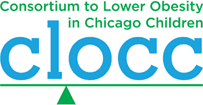Food and Beverage Access
 Across the nation, many people have limited access to fresh fruits, vegetables, and other healthy foods, while availability of calorie-dense and nutrient-poor foods and beverages are plentiful.
Across the nation, many people have limited access to fresh fruits, vegetables, and other healthy foods, while availability of calorie-dense and nutrient-poor foods and beverages are plentiful.
Although practitioners have implemented community-level interventions and incentive programs for retailers to ensure produce and other healthful foods are available in all neighborhoods, there’s still much work to be done.
CLOCC and its partners are leading and supporting a wide variety of community-level interventions to increase healthy food access in neighborhoods. Local interventions include the establishment of healthy corner stores and increasing the number of farmers markets and community gardens in neighborhoods. The city has also passed an ordinance to permit the use of mobile carts to sell fresh produce in communities, especially those considered to be underserved.
CLOCC, along with several city agencies, worked to craft a comprehensive plan to address obesity through building a healthier food culture in Chicago. The process integrated the contributions of over 400 representatives of diverse public, private, and nonprofit organizations and resulted in the creation of a Chicago food plan, A Recipe for Healthy Places.
For more information about Food and Beverage Access, please refer to the Blueprint.
References
- U.S. Department of Agriculture. Access to Affordable and Nutritious Foods: Measuring and Understanding Food Deserts and Their Consequences. 2009. http://www.ers.usda.gov/media/242675/ap036_1_.pdf.
- Borradaile KE, Sherman S, Vander Beur SS, et al. Snacking in children: the role of urban corner stores. Pediatrics, 2009. 124(5): 1293-1298.
- Chicago Department of Public Health. Healthy Chicago: A Public Health Agenda for a Healthy City, Healthy Neighborhoods, Healthy People and Healthy Homes. http://www.cityofchicago.org/content/dam/city/depts/cdph/CDPH/PublicHlthAgenda2011.pdf.
- Centers for Disease Control and Prevention. Chicago, IL, High School Youth Risk Behavior Survey, 2011. 2011. http://apps.nccd.cdc.gov/youthonline/App/Results.aspx?LID=IL.

